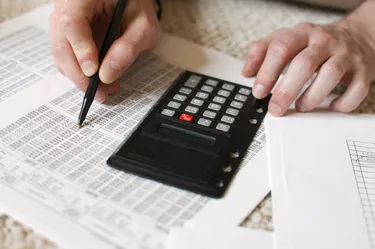
Calculating the value of your portfolio can be more complicated than simply adding up the worth of your stocks. Depending on what type of investments you have, their tax status, interest features and other factors, you should consider more than just the bottom-line value of your portfolio today.
Reviewing some of the things you need to consider when looking at your wealth will help you decide among different types of investment options and make smarter decisions in the future.
Video of the Day
Video of the Day
Define the Word "Value"
What do you mean when you consider the "value" of your portfolio? Are you talking about the market value? Are you talking about what you would get after taxes, fees and penalties if you liquidated your portfolio? Can you borrow against any of your investments? Decide what you mean by "value" so you can decide what your portfolio is worth.
Read More: How to Calculate Average Yield
Do a Simple Calculation
A simple way to calculate your portfolio value is to look at its current market value (without considering fees and taxes). If you own 300 shares of a stock that's currently at $45, that stock has a market value of $13,500. If you have a certificate of deposit that will be worth $1,120 when you cash it in, you can use that value or call your issuer to find out what its value is today.
If you have a 401(k), look at your last statement or log in to your online account to see what's it's worth today. Add your different assets and find your total portfolio value.
Look at Your Costs
Look at the taxes, fees and penalties you would pay if you sold your stock, cashed out your IRA or liquidated any other assets. Some retirement assets let you borrow the money for 30 days without a penalty. If you use a broker to sell your stock, you might have to pay a commission or transaction fee and capital gains tax.
Once you know the taxes, fees and penalties for liquidating each of your portfolio assets, re-run the numbers you did in your simple calculation (described above) to determine your current liquidity. This will help you determine a different portfolio value meaning.
Read More: Investment Loss & Tax Deduction
Find Your Gain or Loss
If you want to know how your portfolio is performing and find the value of change since the last month, quarter or year, perform the simple calculation of your portfolio investments at the beginning of a period and compare it to the end value. For example, if your portfolio value was $38,000 on December 31, and your value was $40,000 on March 31, your value increased by $2,000, or about 5 percent, during the first quarter.
Read More: Dividends Vs. Interest
Don’t Forget Dividends
If you have stocks that pay quarterly dividends, consider what your payments might be this quarter. You can do this by looking at your past dividends and the company's current performance.
It's a long shot that you'll be able to predict whether or not any dividends will be paid this quarter and what the amount will be, but if you've been getting a fairly consistent dividend payment the last year or two, you can consider that as you try to determine your portfolio value.